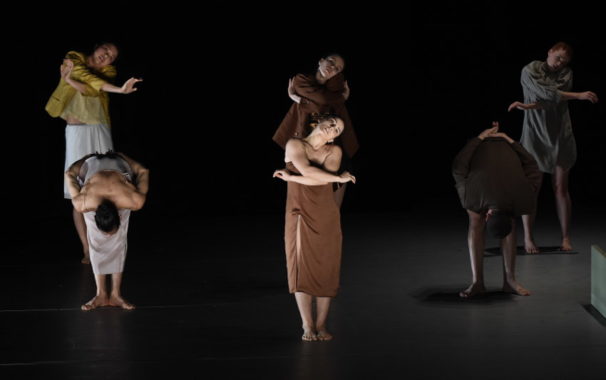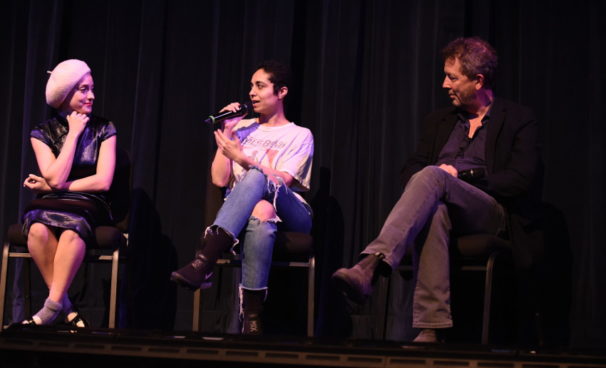
“Let it simmer.” With those words, the music savant Michael Jackson directed his band in This Is It, a documentary capturing his final, unrealized rock concert. MJ’s instrux came to my mind while watching the dance splendor choreographer Danielle Agami unveiled at the Wallis Annenberg Center for the Performing Arts this weekend. The Israeli-born Los Angeleno’s intriguing, slow-paced performance came courtesy of her excellent and alert dance company, Ate9. The eight-member troupe “occupied” the stage of The Wallis, a theater that has made great strides in presenting Los Angeles dance companies.
The first and better of the evening’s works, if such a ranking is helpful, was Agami’s very winning world premiere, “a blind LAdy,” which enjoyed a cool electric soundscore by and on-stage guitarist, Lourdes Hernandez. An earlier work, “calling glenn” featured percussionist Glenn Kotche (he of the bells and whistles also of Wilco), who even had his own drumstick-rattling solo. But hey, the dance is named after him.

Agami’s oeuvre is devilish, highly stylized, and emanates, in an cloud of mystery, from the body-smarts of a choreographer just plain in love with movement. She has stewed a secret sauce that links her strange and idiosyncratic movement vocabulary with intelligence and grace. She likes to strike geometric poses, then melt them into liquid curves. She likes real-time movement-puzzles; so, you watch a dancer get messed up, entangled, or otherwise weirdly occupied either alone or with a partner, and then solve the problem.
First immersed in ‘gaga’ dance language as a member of Batsheva Dance Company (the mothership lands at UCLA Royce Hall in a month), Agami is also a graduate of the Ministry of Silly Walks. Every body part is activated; it’s as though she charges her dancers, like cellphones, off stage, then unplugs them for duck walks, thigh slappings, hand-clappings. She also grasps the big picture as a dance architect. I especially liked the mise-en-scene of her second work, an exposed stage with scattered sculptural elements: Kotche’s huge drum kit, her dancers, lighting poles. To circumscribe the space, she launched the troops in a boisterous marching promenade. The Ate9 members gave it their all—and there’s no question that they work in a dominant-feminine modality with the men essentially crossing over to speak female bodytalk.
Many moments! When Montay Romero first stumbled in a falling, exhaustive solo, the audience thought they saw an accident. They did … the accident of life. The tone skewed toward severe, but occasional, necessary humor arrived almost as a release. (While I “got” the video/’commercial break’ in “LAdy,” it could have been more effectively implemented, yes, a non sequitur, perhaps projected too largely?)
In notes, Agami says this work reflects the “insecurities and absurdities” of life in Los Angeles. She did send the brave Sarah Butler on stage for the best use of human nudity I’ve seen in concert dance, accenting her form, fleshiness, and the shock of the natural. (The program warned of “brief” nudity. Really? She was naked onstage forever.)
Also fetching were the “real” costumes — in hues of green and gold. A simple prop — a bench contraption — started as a bus stop, morphed to a hangman’s structure and closed the dance as a coffin into which one dancer crawled while others made wooshing sounds with their lips. A very far out, strong theatrical ending.

In a program note Agami queried, “The evening is an experience of pleasure and discomfort that subtly asks the question – what are we missing out on when our experience is never allowed to linger?” Strikingly similar to “Let it simmer,” that may be the question of our age. The pleasure was palpable in digging into this special, even spectacular, ‘time-out’ with ate9.
arts·meme founder/dance critic Debra Levine authored this review.
photo credit: dan steinberg
